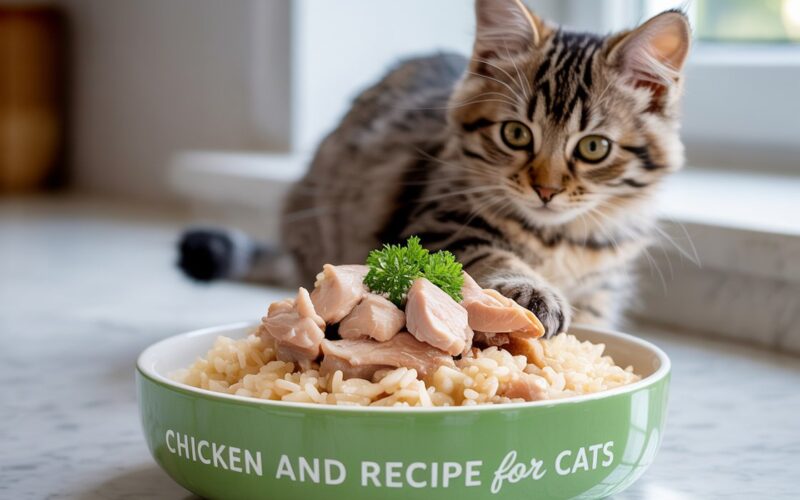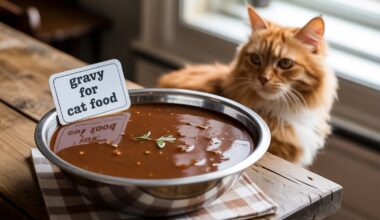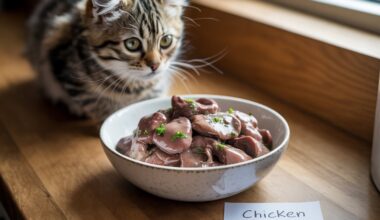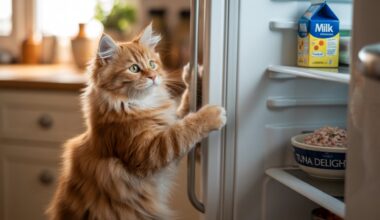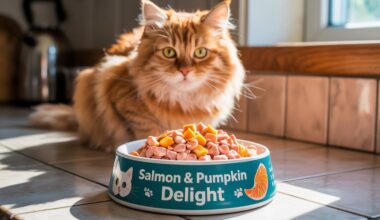Ever looked at your cat and thought, “Maybe I can cook something better than that canned stuff?” Yeah, same here.
Homemade cat food is becoming a thing. Not just a trend. A real shift. Cat parents want to know what’s going into those tiny bowls. And honestly? Cats deserve better.
That’s where the chicken and rice recipe for cats comes in. Simple. Safe. Vet-approved (mostly). It’s gentle on sensitive tummies, easy to whip up, and kind of comforting—like chicken soup for humans, but for whiskers.
I still remember the first time I made it. My tabby, Luna, was sick—diarrhea, low energy, not herself. The vet suggested boiled chicken and plain rice. She sniffed it. Then devoured it like it was a feast from the gods. That’s when I knew: this stuff works.
In this guide, I’ll walk you through everything—step-by-step cooking, feeding tips, what to avoid, and yes, even some vet-backed advice. All based on real experience. No fluff. No overpromises.
Just one cat parent to another, trying to keep our furry ones healthy—and maybe save a bit on store-bought food too.
So, if your cat’s been having stomach issues, or you’re just looking for a cleaner option to feed, this post’s for you.
Is Chicken and Rice Good for Cats?
Chicken and rice. Sounds basic, right? But for many cat parents, it’s a go-to meal—especially when their fur baby isn’t feeling well. One night, my friend’s cat, Luna, was puking non-stop. Vet said, “Try boiled chicken and rice.” Simple. And it worked.
Why chicken? It’s lean, rich in protein, full of amino acids like taurine that cats literally need to survive. Not optional. They don’t make it on their own, so they gotta get it from food. Chicken’s a great source.
Now rice… that one’s a bit more controversial. Cats are obligate carnivores, right? True. But rice isn’t the villain some folks make it out to be. It’s bland, easy on the stomach, and helps add some bulk. White rice especially—soft, starchy, quick to digest. When your cat’s got diarrhea or recovering from tummy trouble, boiled chicken and rice for cats can be magic.
But hey—don’t overdo it. Not all cats can handle grains. Got a cat with allergies? Or kidney issues? Yeah, skip the rice. Even chicken can be a problem for some, believe it or not. This isn’t an everyday meal—it’s more like a gentle, temporary fix.
Moral of the story? It’s good… until it’s not. Know your cat. And always—always—check with your vet before switching up the menu.
What Can Cats Eat from the Fridge ?
Yes, You can give your cat some food from the fridge, but you need to be careful. Always check the ingredients and freshness before giving anything new. Feed small amounts and watch for any adverse reactions from your cat. Foods that are safe to give to cats from the Fridge
When to Feed Chicken and Rice to Cats
Sometimes, cats just stop eating. Or they throw up everything you give them. That’s when chicken and rice steps in. It’s bland. It’s simple. It calms their stomach.
After a night of vomiting, my cat Luna wouldn’t touch her usual food. I panicked. Vet said, “Boil some chicken. Plain white rice. No salt.” I did. She sniffed it. Then ate it like she hadn’t eaten in days. Within 24 hours, she was back to herself. No more puking. Energy up. Appetite back.
This combo—boiled chicken and rice—is often used for digestive issues. Diarrhea? Try it. Sensitive stomach? Yep. Just had surgery? Also works. But remember—it’s not forever food. Cats need more than just protein and carbs.
Vets usually say 2–3 days max. Then slowly reintroduce normal cat food. Chicken and rice lacks taurine, vitamins, fat—all the good stuff cats need long-term.
Still, it works like magic when timed right. Think of it as first-aid, not daily dinner.
Every cat’s different though. What works for Luna might not for yours. Always check with your vet. Always.
Ingredients Breakdown: What You Need
Alright. Let’s keep this simple. You don’t need much. Just a few safe, clean ingredients—stuff your cat’s tummy will thank you for.
The Basics
First up—boneless, skinless chicken breast. Lean, protein-rich. No fat, no skin, no bones. Around 100–150 grams should do for one serving.
Then comes white rice. Not brown. White. It’s easier to digest. Go for about 1/3 to 1/2 cup cooked. Plain, soft, mushy rice.
And that’s it. That’s the core.
A Few (Optional) Extras
Now, some cat parents like to toss in a spoon of pumpkin puree—just a bit. Good for digestion. Or a few drops of fish oil. Shiny coat, happy gut. But—talk to your vet first. Always.
What Not to Add—Seriously
This part? Super important.
No garlic. No onion. Not even a little.
No salt. No butter.
No seasonings. Nothing you’d use in your own dinner.
Cats are different. Their system’s not built for flavor. Just fuel.
I once added a pinch of salt by habit. My tabby sniffed it, stared at me, and walked off. Lesson learned.
So yeah. Stick to the basics. Your cat doesn’t care about gourmet. Just safe, simple, clean food.
Step-by-Step: Chicken and Rice Recipe for Cats
You don’t need to be a chef to make this. Just a cat lover with 20 minutes and a stove.

a. Boil or B ake the Chicken
Boiling is simple. Throw in boneless, skinless chicken breast. Let it simmer. No salt. No oil. Just water. It keeps things soft—gentle on your cat’s stomach. Baking? Fine too. Just skip the seasoning. Downside? Sometimes a bit dry. Some cats mind.
Once cooked, cool it. Then shred it—fingers work best. Or a fork. Tiny pieces, easy to chew. No chunks. No bones. Always double-check.
b. Let’s Cook the Rice
White rice. Not brown. Why? Easier to digest. Brown’s got fiber—great for us, not so great for sensitive feline tummies. Use plain white rice. 2 parts water, 1 part rice. Boil till soft, not mushy. Let it cool. Room temp is perfect.
c. Mix Like a Pro
Now mix. A simple 2:1 ratio—two parts chicken, one part rice. Stir gently. You want balance in every bite. Not too dry. Not too wet. Think soft, not soggy.
That’s it. You’ve just made a chicken and rice cat food recipe that’s gentle, healthy, and vet-approved. Great for sensitive stomachs. Many cats love it.
And hey—this boiled chicken and rice for cats? It’s not fancy. But it’s honest. And your cat? They’ll know.
Best cat food recipes with fish : Salmon & Pumpkin Delight
I created Salmon & Pumpkin Delight for my cat, cat food recipes with fish is home -made food or supplemental food. Salmon and Pumpkin are usually safe and beneficial material for cats. However, some important things should be kept in mind when preparing a homemade cat meal.
How to Store Homemade Cat Food
You cooked it. Smells good. Your cat’s already circling. But—wait. You’ve made a big batch. What now?
Storing homemade cat food is kind of like storing leftovers for your kid. Only your cat can’t tell you when something smells off. So you gotta stay sharp.
First off, cool it down. Don’t toss hot food into the fridge. Let it reach room temp, then scoop it into airtight containers. The fridge? Safe for about 2-3 days. After that, nope.
Freezer? Way better. Divide it up. Use small, freezer-safe containers or silicone ice cube trays. One cube = one meal. Smart, right? Saves time, avoids waste.
A story for you—Sara, a cat mom from Oregon, once kept a batch for a week. Looked fine. But her tabby refused it. Turned out: slight sour smell, texture changed. Lesson? Trust your nose, and your cat’s behavior.
Oh, and mold. If you see fuzz or smell something “off”—toss it. Don’t take chances.
Quick tip: label the date. You’ll forget. Everyone forgets.
Portion control is your best friend here. Don’t defrost the whole thing if your cat only eats half a cup. Small batches. Big peace of mind.
Cats deserve fresh. So, treat their food like you’d treat your own.
Cat Food Substitute Guide.
Many people are hesitant about Cat Food Substitute or cat food options. What is safe to feed and what is not? Now we will know alternatives to Canned Cat Food, Cheap Alternative to Cat Food, and effective solutions related to Emergency Cat Food. In it you will find Cat Food Replacement Ideas that can be easily created that is not harmful to your pet’s cat’s health.
Feeding Guide: How Much Chicken and Rice to Serve
Feeding your cat chicken and rice? It’s not a one-size-fits-all thing. Trust me, I learned this the hard way.
Last winter, my senior tabby, Luna, had a tummy bug. Vet said bland food. I went with boiled chicken and white rice. Simple. Clean. Gentle.
But how much?

Start Small
For kittens (under 6 months), just a tablespoon or two per meal. Maybe 3 times a day. They’re tiny. Fast metabolism. Don’t overdo it.
Adult cats? Around ¼ to ½ cup per meal. Twice a day is fine. Older cats, like Luna? Slightly less—unless your vet says otherwise. Keep it light.
Easy Does It
Day one: swap out 25% of their regular food with chicken and rice.
Day two: 50%.
By day three or four, it’s a full switch—if their stomach agrees.
But don’t feed this forever. Not balanced for the long haul. It’s more of a recovery meal. Or an occasional treat.
And hey—watch their poop. If it gets too loose or too hard, adjust. That’s your cat’s way of texting you, “Hey, not working!”
No spices. No oil. Just boiled love.
Need to feed more? Watch their weight. Energy. Water intake.
Each cat’s different. That’s the beauty—and the headache.
Vet-Approved Tips for a Balanced Diet
Okay, so here’s the deal — chicken and rice is pretty good for a cat, but mostly for emergencies. Such as when they have an upset tummy, or simply need something that’s easy on their stomach. It’s very much not a long-haul full meal. Why? Because cats require a whole bunch of OTHER nutrients, particularly taurine, which is immensely important for their hearts and eyes. Chicken alone doesn’t cut it.
Here’s one way to look at it: suppose you only ate chicken and rice day in and day out. You’d be missing a bunch of vitamins and minerals, wouldn’t you? Same with cats. That’s why vets usually say, “Use this recipe short-term.” Otherwise, you gotta add supplements or special vitamins to keep your cat healthy.
Some vets recommend taurine supplements or fish oil, which are good sources. Here’s a quick fact — studies (like one from the Journal of Animal Physiology) show taurine deficiency can cause serious problems in cats. So don’t skip this part!
Dr. Sarah Thompson, a feline nutrition expert, once told me, “Homemade meals can be great, but they need careful balance. Without it, you risk nutrient gaps that harm your cat’s health.”
Bottom line? Chicken and rice recipe = great for recovery or treat days. But for everyday meals? Get the vet involved and consider supplements. Your cat will thank you with lots of purrs!
Common Mistakes to Avoid
Okay, so here’s the deal — chicken and rice is pretty good for a cat, but mostly for emergencies. Such as when they have an upset tummy, or simply need something that’s easy on their stomach. It’s very much not a long-haul full meal. Why? Because cats require a whole bunch of OTHER nutrients, particularly taurine, which is immensely important for their hearts and eyes. Chicken alone doesn’t cut it.
Here’s one way to look at it: suppose you only ate chicken and rice day in and day out. You’d be missing a bunch of vitamins and minerals, wouldn’t you?
Next, never use seasoned chicken or instant rice. I know, it’s tempting to grab whatever’s quick. But garlic, onion, salt — all those seasonings are toxic to cats. Even a little can cause serious problems. Same goes for instant rice. It’s processed and might upset their digestion. Stick to plain, boiled chicken and regular white rice only.
Here’s another trap — feeding this chicken and rice recipe too often or as a full-time diet without checking with a vet. This recipe is great for sick cats or short-term use. But feeding it daily without vet guidance? Not good. Cats need balanced nutrients that this simple dish might not cover. So, please don’t make it their only meal forever.
In short: cook right, keep it simple, and don’t overdo it. Your cat will thank you.
Alternatives and Additions
You know, sometimes cats just get tired of the same old chicken and rice. My cat, Milo, sure did. One day, I tossed in some pumpkin puree. Just a little spoonful. And guess what? He actually liked it! Pumpkin helps with digestion, plus it adds fiber. Easy win.
Then I thought, why not peas? I popped a few peas in the mix. They give some crunch and vitamins. But heads up—cats can be picky about peas, so don’t go crazy. Try a bit first. Oh, and fish! Cooked salmon or sardines. No bones, no seasoning. Fish adds omega-3s and makes the meal feel fancy. Milo went nuts for it.
Now, not everyone has time to cook every day, right? There are commercial options that mimic homemade recipes pretty well. Brands like Natural Balance or Blue Buffalo Basics have chicken and rice cat foods made for sensitive tummies. They’re hypoallergenic too, which is great if your cat has allergies. No drama, just easy feeding.
If chicken isn’t cutting it, no worries. Hypoallergenic alternatives like duck, venison, or rabbit are out there. They’re gentle and tasty. Cats with sensitive stomachs can enjoy these too.
So, mix it up. Keep your kitty curious. It’s all about variety—and making mealtime fun.
Homemade vs. Store-Bought Cat Food
So. I once knew a guy who swore by cooking for his cat. Chicken. Rice. A little boiled carrot, maybe. No preservatives, no factory smells. Just love in a bowl, y’know?
But then his cat started losing weight. Slowly. Quietly. He thought it was normal—age maybe. Turned out she was missing taurine. Badly.
See, homemade food sounds great. And it can be. You control everything. The meat, the rice, the care. But… you’re not a cat nutritionist. Neither was he. Most of us aren’t.
Store-bought? It’s easy. Scoop and done. Some brands got formulas approved by vets. Balanced. Consistent. Not all brands, though. Some use fillers. Weird byproducts. Stuff you can’t even pronounce.
But they do get one thing right. Convenience. And safety, most of the time.
So—what do you do?
Honestly, it depends. Got time and a vet to guide you? Homemade could work. But don’t wing it. Ever. Or you could go for a mix. Homemade as an occasional treat. Store-bought for balance.
That’s what I do. Works fine. My cat’s happy. Still sprints at 3 a.m. Full zoomies.
FAQs: chicken and rice recipe for cats
Can kittens eat chicken and rice?
Sure, they can. But slow down—only sometimes. Think of it like baby food. Kittens have tiny bellies and big needs. A bland chicken and rice meal? Might work during tummy troubles. Not every day, though. Not forever. Always check with a vet first. Their growing bodies crave more than just plain meals.
How long can I feed this to my cat?
Here’s the deal. A few days? Totally fine. A week? Maybe. A month? Nope. Chicken and rice isn’t a full meal. Not long-term. Cats need taurine, fats, vitamins… stuff rice just doesn’t give. This recipe helps with recovery. It’s not a lifestyle. Think of it as a gentle reset, not a diet plan.
What if my cat refuses to eat it?
Oh, that happens. Cats are… well, cats. One day they love chicken. Next day? Nope. Try warming it a bit. Add a dash of tuna water. Mash it smoother. Some cats like chunks. Others don’t. It’s trial and error. If they still snub it? Don’t force. Go back to their regular food. Or call the vet. Always the vet.


